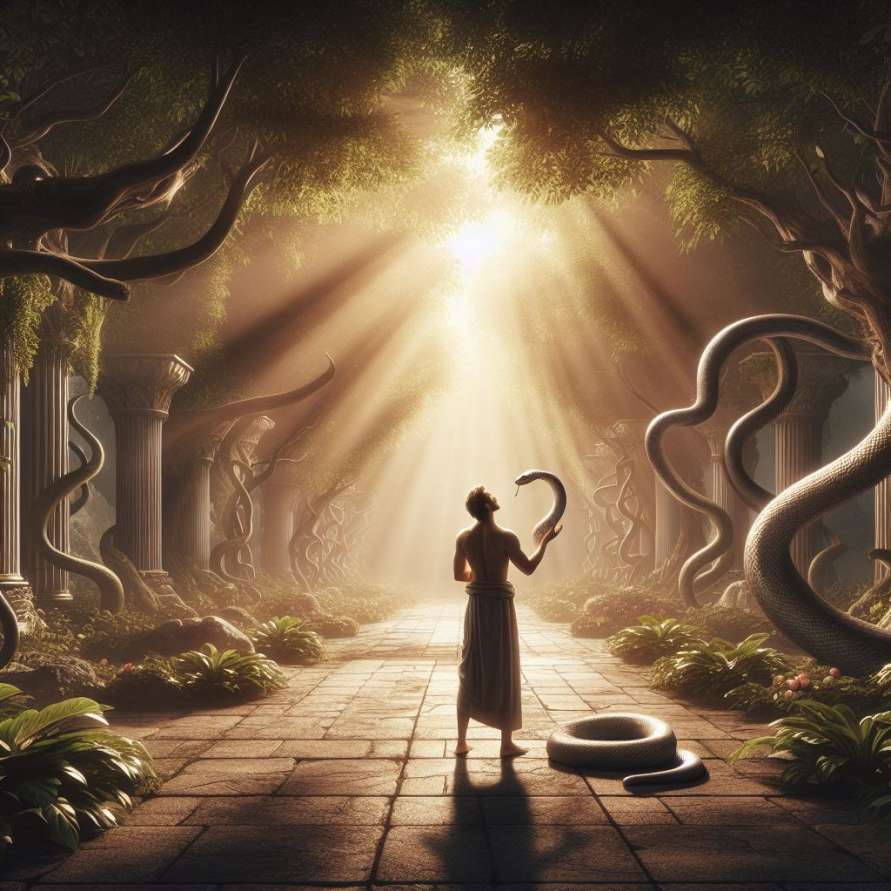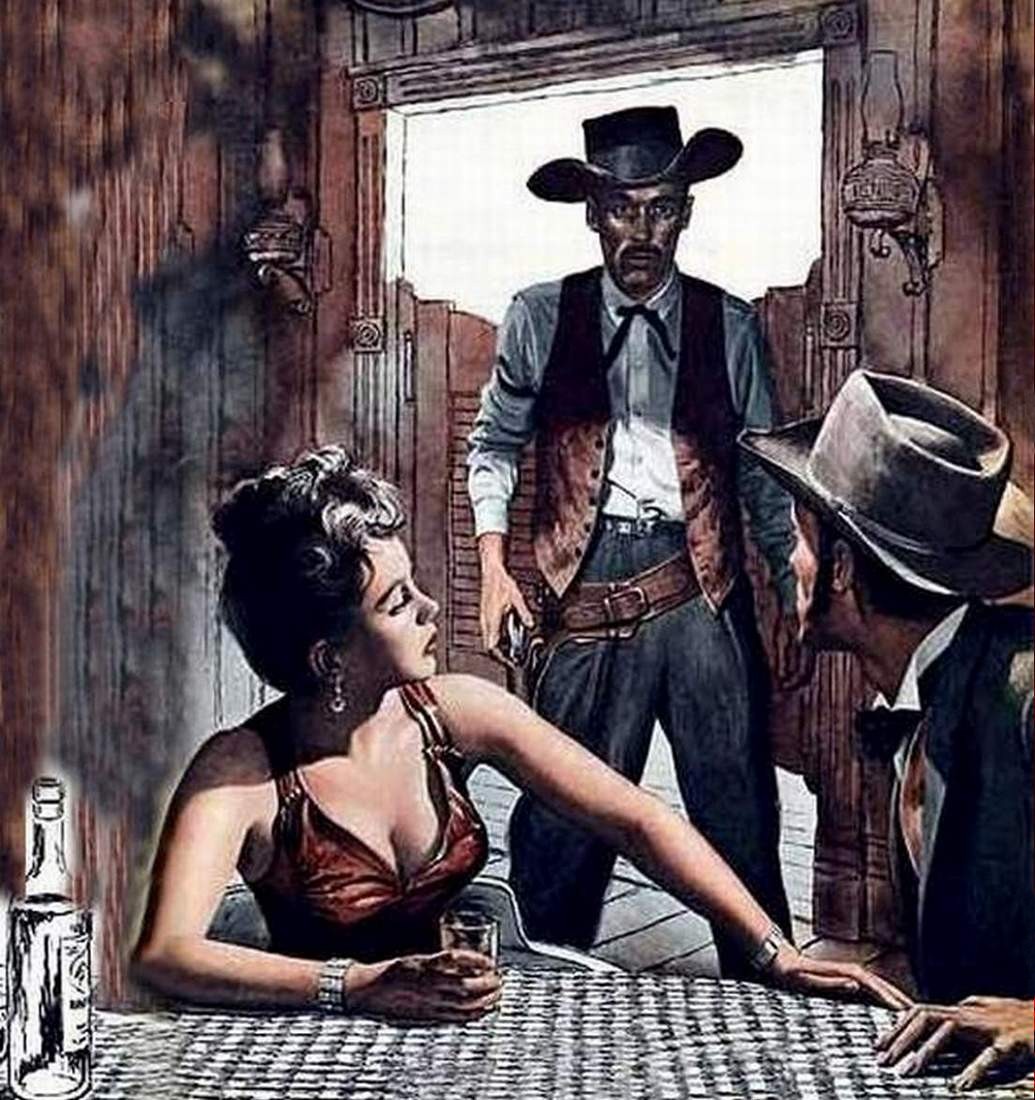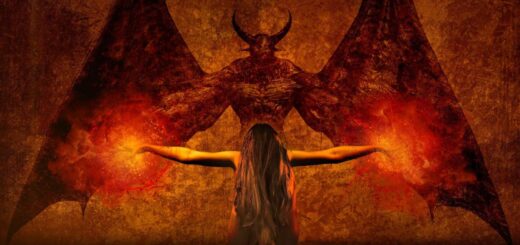Biting Worms by RK Greer

Biting Worms by RK Greer
It is now well after sunset and Pearce is on his fabric camping chair in his yard, drinking a beer. It was a hot day, but now the night weaves in like a cool sheet and drops toward the ground. His wife is talking, but Pearce is focused on a crinkling, tinfoil-like sound that he first thinks is a large bug, perhaps a locust or a cricket, crawling over the leaves near his feet. Then he sees it – swaying, the thickness of a fat bratwurst and at least three feet long. It lifts up its head, forming a question mark shape as it moves toward his feet, pulling the rest of its body behind, slowly continuing for what is a few seconds but seems like nearly a minute. In a whisper Pearce says to his wife, “That’s a big snake.” She looks and scoots her chair backward as the creature moves along a crevasse where the ground has sunk perhaps four inches under the sidewalk leading to their front door. They stand slowly and move backwards into the house, watching from the doorway as it disappears, melding into the blades of grass. The sight of it – so large with its distinct cat-like eyes, its skin covered by an hour-glass pattern and its diamond-shaped copper head – activates fear and undermines Pearce’s ability to think. They both thaw from the frozen fear, and with the snake now gone, Pearce leaves and returns with a flathead shovel, which he leans against the brick wall.
It was not Pearce’s first encounter, but he kept that initial reptilian confrontation secret. Pearce has seen snakes in the deep ivy on the side of the house, where, over the years, the plants grew thick, climbing the brick walls, weaving inside the gutter downspouts and encircling trees. He had put on his boots and walked into the thick brush, reached to the ground and pulled on a vine only for it to snap; the roots had grown too deep to be pulled by hand. He backed away and reached for another vine, and as he did leaves rustled and the head of a snake rose, mouth wide, fangs ready to strike. Pearce rushed backward to safety and has avoided the area since.
Now, with he and his wife shielding themselves inside, Pearce thinks he should perhaps recommend renting a backhoe to clear out the area. But instead, he minimizes the threat.
“It’s probably because of the bread and seeds,” he tells his wife. He has been throwing seeds and chunks of stale bread into the front yard, hoping to attract birds and chipmunks. He is successful, and he and the cat watch the animals scampering in the mornings, filling their cheeks and beaks.
“What I did,” Pearce says to her, “was unintentionally attract snake bait.” That is likely true, but he fails to mention the snake farm he allows to thrive in the nearby ivy.
The next morning sunlight fills the yard as Pearce steps into it, still feeling a tinge of fear in his spine from the night before. He scans the grass carefully. “God-dammit,” he mumbles, as a snake weaves in the blades. It is small, with no distinct markings, certainly not a copperhead, but still an intruder, taunting him. He walks backward toward the wall to the flathead shovel, keeping his eyes on the spot in the grass where he sees the snake, fearing the danger might disappear before he could kill it. He reaches for the shovel and brings it down fast and hard on the snake just behind its head. It isn’t enough to separate the head from the body, but it is enough to break the snake, its head now at a sharp right angle to the ground. The tongue flickers like a flame burning in its wide-open mouth and Pearce’s fear and anger transform to pity, and then to guilt. He raises the shovel again, hoping to end the creature’s misery that he created, and with the danger seemingly gone, brings the shovel down more slowly and accurately, intending to completely sever the head from the body. While it works, it now appears as if there are two living things. The head seems to stay alive, the mouth agape and tongue lashing, while the rear of the body writhes in the grass. Its eyes focus on Pearce, as if to ask, “Why?” For a moment he stands above the creature, their eyes locked. A brick to its head ends the movement.
“I’ll never kill another living thing again,” Pearce says to himself, the image of the mutilated animal gasping for life lodged in his mind. Before anyone can notice, he buries the pieces in the yard where it died. He tells no one.
& & &
His wife is panicked. Her face is flushed of color. “Snake. There’s a snake. Lock the doors,” she says in a hushed voice. Pearce asks why she is whispering. “Snakes don’t have ears,” he tells her. He follows her downstairs to the garage, where a large copperhead – bigger than the one they had seen in the yard – is coiled around a pair of shoes. Pearce grabs the flathead shovel and examines the snake’s positioning. It is probably too big to simply scoop into the shovel. He retreats and opens the garage door, thinking the creature would perhaps simply leave. It does not, remaining motionless around the shoes. Pearce approaches, intending to push it outside with the shovel, but the snake raises its head and rather than moving forward, surprises Pearce by slithering sideways across the concrete floor into a corner underneath a shelf.
“I don’t want to kill it. I just want it to leave,” Pearce tells his wife. He crouches and says brightly to the snake, “Come on buddy, you’ve got to get out here.” The snake does not oblige. He pounds the shovel into the cinderblock wall, attempting to scare it, which is successful – the snake is now frozen with fear, laying still beside a few small chunks of the wall that have fallen. Pearce kneels to examine the snake’s position.
“I have an idea,” he says. He plugs in the air compressor he has used to power a nail gun and blows a steady stream of air onto the snake’s head. Pearce watches as the snake’s skin ripples as if it were in a wind tunnel, but the creature still doesn’t move. He returns to the shovel and gently pushes the copperhead toward the garage door opening and the snake races to the center of the driveway. “No, not there,” Pearce yells. He reaches for the hose beside the garage door and turns the water on high, creating a wave on the driveway that he manipulates in an effort to push the animal.
“What are you doing? Why are you watering the snake?” his wife asks.
“I’m trying to get it down the driveway and into the storm sewer,” Pearce says, aiming as strong of a stream of water as possible. He has forced the snake nearly half-way down the driveway when it breaks away from the water, scurries to the dirt and brush, and disappears.
“It’ll probably be back. Maybe I should have killed it,” Pearce says.
& & &
Pearce is hauling Christmas boxes from the attic, preparing to unpack a plastic tree, ornaments, and other decorations. There are multi-colored lights, white ones, tinsel, and Santa Claus statues. He opens the box with the tree parts, snaps them together, places the completed tree in the stand and plugs in the lights. He stands back to examine his work and its placement in the room. He returns to the tree and begins moving it closer to a corner, when he sees small objects attached to the limbs. They are hanging, motionless. He moves closer. They are small snakes, dead and crisp, hanging like tinsel. He shivers and backs away. The box that held the tree comes to his mind – he should check it, he thinks. Pearce tiptoes to it and leans over to look. Attached to the tape that held the box closed is a snake, perhaps nine inches long – or tall, as it is positioned vertically. It is struggling to free itself from the adhesive. He grabs a fresh roll of tape and winds more over the snake, encasing it until it cannot move. Gingerly, he carries the box to the basement fireplace where logs are burning and presses it into the fire. He waits as the flames consume the cardboard and watches as the snake twists on the melting tape.
“We’ll need to get a new box for the tree when the holidays are over. I used the old one for kindling,” he tells his wife, without mentioning the cremation.
& & &
Pearce is having one of those dreams that should be frightening, but it isn’t. He walks into his garage, where his daughter is smoking a cigarette. She says, “Hi,” and returns her attention to her cell phone. Pearce sees the small snake circling her bare feet.
“Don’t move. Don’t move,” Pearce says calmly. “Snake.” She looks away from her phone and to him, and says, simply, “Ok.”
He is frustrated that she does not seem to understand the gravity of his warning. He repeats it again. “Snake.” As the word leaves his mouth, a second snake appears, following the first one around her feet. He wants to warn her again, but fears it is his words that are creating the danger. With every mention of a snake, another appears, so he simply points to the floor where she stands. She laughs.
& & &
It is spring and Pearce is walking down the steps to the basement when he notices a shoelace at the bottom of the stairs. Strange, he thinks, that it would be there, as if it had simply fallen out of a shoe. Then it moves. The movement sends familiar shivers through Pearce and for a moment he is still with trepidation, stalled halfway down the steps. He turns back, retrieves the flathead shovel and returns to the basement steps. Pearce expects the snake will have moved and he will have to search for it, but it is still there. “In my house? I don’t think so,” he proclaims as he brings the shovel down on the snake just behind its head, then an inch further back, another inch further back, and another inch further back, and then across various parts of its body, chopping it into dozens of pieces and ripping chunks of linoleum from the floor in the process. “And I don’t feel bad about it,” he mutters as he sweeps the carnage into a dustpan and unceremoniously dumps it into a garbage pail, covering the body pieces with other trash to conceal the killing.
After dark that evening Pearce is on the front porch preparing to fold up his fabric camping chair and go inside when a black sedan drives slowly past his house. He pauses and listens to the vehicle engine grow distant. Then it returns. He watches the car crawl beside the house and onto his driveway. It is too late for visitors. He warily stands, hoping the driver is simply lost and will back away to leave. Instead, the driver lowers his car window.
“Good evening,” the driver says in a calm, monotone voice. Pearce is certain danger is afoot – a suburbanite gone haywire, perhaps – and backs toward the house to the flathead shovel, thinking that if the driver is unarmed, he would have the advantage. “Hello. Can I help you?” he yells to the driver, holding the shovel as a weapon in a Rockwellish pose. The man’s voice intensifies and he replies loudly and distinctly, as if making an announcement: “Copperhead coming down the street. Went into the ditch in front of your house, came out and is coming up your driveway, about 2 o’clock from you. This is the time of year when they have babies. Just wanted to let you know.” It seems preposterous the driver could see the snake in the dark. He grips the shovel tighter. “Oh, ok, thanks for letting me know,” Pearce tells him, the words squeaking from his tightened throat. He waits for the man to leave. The driver holds his hand out the window with his thumb up, says, “Yep,” and slowly reverses out of the driveway to the street, where he pauses and yells to Pearce: “You might want to clean out that ivy forest on the side of your house. Copperheads love making nests in ivy. It’s party city to them. That could be where it came from.” As the man leaves, Pearce considers creeping down the driveway with his flathead shovel, but it is too dark, and instead he retreats inside the house. He locks the screen door and the two deadbolts to the house door.
In the morning, he walks across the lawn, sure that even if a snake been there the night before it was likely long gone. Nonetheless, he creeps alertly, watching each spot in the grass where he places his feet. He notices a small lump on the lawn, walks closer and sees a mutilated chipmunk on its back. Skin is missing from its belly as if it were burned off by acid. Pieces of bone poke from its legs and much of its body is gone. He gazes across the lawn to the street and back to the ivy patch before returning inside.
“Anything interesting in the front forty today?” his wife asks, facetiously.
“Not a thing,” Pearce says.
& & &
“It’s just a preventative measure,” Pearce says to his wife as he staples a laminated, color photo to a stake. In bold type below the image of a copperhead are the words, “If this is you, turn back under penalty of death.” He cleans out debris from under bushes and erects foot-tall screen barricades around the porch. As he pounds a post into the ground, he thinks he spots a small snake head protruding from underneath the porch, onto the sidewalk. It bobs its head and darts back underneath. Pearce plugs the gap with dirt and rocks, but soon the rocks have been moved. Pearce stands holding the shovel above the gap, waiting. The snake nose reappears, he brings the shovel down, but misses, and the snake darts back in. Pearce and the snake repeat the drama several times until the entire head of the snake protrudes and Pearce brings the shovel down with rapid force. The snake’s head remains attached, but it is clearly severely injured, slowly moving and tilting its head sideways, its eyes looking up to Pearce, as if to ask, “why this again?” before retreating under the porch. He plugs the entire gap under the porch with rocks and spray foam, reinforced with two-by-fours. Soon the distinct odor of rotting flesh rises from the porch and lingers for days. His wife drags away the old wet doormat from the porch. “That must be what smells so bad,” she says.
& & &
Pearce says he does not want all four of the neighbor’s kids coming over. “Four is too many to handle,” he says. Invariably they would fight, or one would be left out, or one would get hurt – it was more children than he is interested in. But he eventually relents and agrees, though he has not released all his resentment. The children are each five years old. His wife has made a lunch for them of grilled cheese sandwiches cut into bite-size heart shapes placed on the outer edge of a big plate with potato chips and pickle spears in the middle. When the children finish eating, Pearce gives them sand buckets and plastic toy shovels and shoos them outside to play in the backyard. “It’s a beautiful day. Play like you’re at the beach,” he says. “I’ll be out soon.”
His wife is looking through the kitchen window as she washes the dishes and sees the children digging with their shovels, carrying back leaves from the ivy patch and filling their buckets. She hears their voices and occasional giggles. Pearce steps outside to check on them. He sees only three children and asks them the whereabouts of the fourth.
“He’s on the side of the house. There’s pretty plants there,” says one child. The child holds up a piece of ivy, but Pearce does not notice and returns inside.
“How are the kids doing?” his wife asks.
“Seem fine, entertaining themselves,” Pearce replies.
She finishes the dishes and walks to the backyard. There are still only three children gathered around the pile of leaves with their buckets, but the fourth has returned and sits with his back against the brick wall of the house. “Tommy? What are you doing?” she asks. When the child stares ahead as if a zombie, she thinks he is playing a game. “Oh, you’re scary!” she says. “How about some lemon-aide kids?”
She makes a jug of lemonade and brings four cups, their rims lined with sugar, but finds only two of the children crouched around the pile of leaves with their shovels and buckets. A second child is now sitting with his back against the brick wall where Tommy had sat, but Tommy has fallen over and is on his side. As she approaches, a third child stumbles toward the wall.
The fourth child is on his knees with the bucket and shovel still in his hand, grinning as he reaches into the leaves and ivy and excitedly holds up a pile of what appears to be large worms, writhing and intertwined like knotted shoelaces. Their small tongues dart in and out of their mouths. “They’re biting worms!” the child says as he stumbles toward her and holds them up to her face.
When the paramedics arrive the four children are breathless and motionless. The police arrive, too, and soon the yard is swarming with emergency personnel and flashing lights fill the street.
The children’s hands and arms are swollen, covered with pinprick blood-marks. “Baby copperheads,” says a paramedic, standing over the bodies, shaking his head. “They live in the dirt, under logs, beneath porches, in overgrown brush like ivy, in garages, and until they get bigger, they can actually climb quite well. Look like big worms. Thing is, they’re born with a lifetime of venom.”
The police officer stands with a metal clipboard. “They’ve been a major problem lately, the copperheads,” he says. “You must have a nest of them around here. The coroner is on his way and once he’s done, we’ll get your home back to normal.”
Pearce is silent.
* * * * THE END * * * *
Copyright RK Greer 2023























